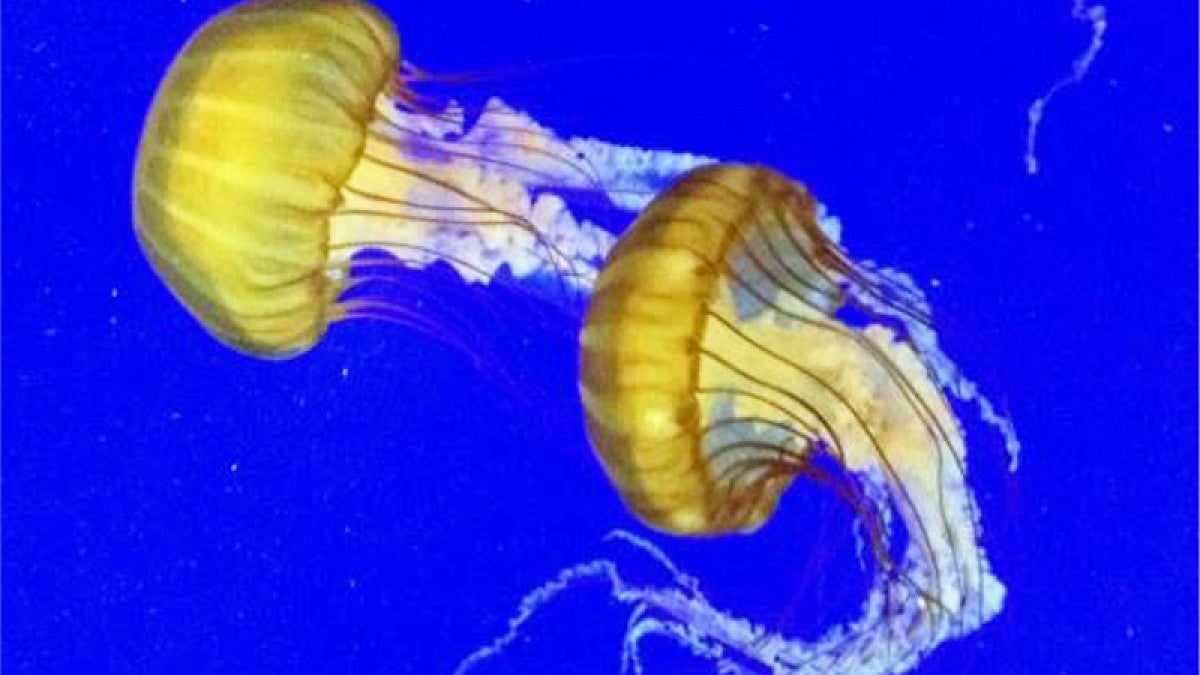Pizza lovers, listen up: There is competition for the anchovies you demand. UO research has found that Pacific sea nettles — the largest jellyfish seen along Oregon’s coast — prefer anchovy eggs to other available food choices.
That sea nettles eat such nutritious fish eggs, which are rich in energy-boosting lipids, probably isn’t surprising. Both are part of the ocean food chain. However, the study, published in the Journal of Plankton Research, is the first to identify anchovy eggs in the stomachs of these jellies with the mighty sting.
“Yes, people eat anchovies on their pizza, but the importance here really has to do with some of the other predators, such as larger fish and seabirds, that eat anchovies and may have to compete with jellyfish,” said UO biologist Kelly Sutherland of the Clark Honors College and Oregon Institute of Marine Biology. “This research also tells us a story about the behavior of the prey as much as it does about what the jellies are doing.”
The anchovies seen in the study are a species of small forage fish commonly known as California or northern anchovies. Their near-shore range stretches from Baja California to British Columbia, but recent research suggests their numbers are increasing northward amid rising sea-surface temperatures.
The findings from Sutherland’ s lab provide new baseline information that may be useful for projecting how climate changes may affect predator-prey interactions, the research team reported. “Many players interact in ocean food webs,” Sutherland said. "This helps with a piece of food-web puzzle.”
For the study, Sutherland’s team, led by former graduate student Samantha Zeman, collected jellyfish from 13 stations from Brookings to Queets River, Washington, between June and September 2014. Jellyfish-anchovy interactions were the greatest at the mouth of the Columbia River.
During June, when anchovies are actively spawning, the highest concentrations of anchovy eggs were found in jellyfish stomachs — even though they were less plentiful in the water than small shrimplike crustaceans and larger fish larvae. That, Sutherland said, indicated that jellyfish prefer the tiny anchovy eggs.
It could be that the eggs were just an easier catch for the passive fishing style of the jellies, she said. Sea nettles lure food via their pulsing swimming motion, creating smoke-ring-like vortexes that swirl past the stinging tentacles. Once eggs transition to larvae they become more agile. Like crustaceans and larger fish, they detect such vortexes and flee. Free-floating eggs are easy catches for the jellyfish vacuuming system.
“Jellyfish will not simply eat whatever is around,” Sutherland said. “In fact, it is a selective process. They are picky eaters in that they are just not Hoovering up whatever is there. What’s in their stomachs doesn’t necessarily represent all the prey that is available to them. When fish eggs are around, the jellies may not have many of them in their stomachs, but relative to the other prey that's available they accumulate a lot of fish eggs.”
The project — primarily funded by the National Science Foundation and Oregon Sea Grant — was an eye-opener to Zeman, now a research technician with co-author Richard Brodeur of the National Oceanic and Atmospheric Administration's Northwest Fisheries Science Center at Oregon State University.
“With this project, I saw first-hand how little we know about most gelatinous organisms, even though they are some of the most commonly encountered animals during research cruise surveys,” said Zeman, who was a student at the UO’s Oregon Institute of Marine Biology during the study. “This project was a bit of a struggle, but I gained a deep appreciation for the mystery and many unsolved or unasked questions surrounding jellies.
“Fish have an immediate value, especially here in Oregon, so it is important to tease out the direct and indirect connections between jellyfish and fish,” she added. “Jellyfish are an important part of the marine food web and I try not to vilify them. They have a role, just like whales or salmon, and we still don’t know their full impact on marine ecosystems.”
The study, on which Elizabeth Daly, another technician in Brodeur’s lab, was also a co-author, builds on Sutherland’s efforts to understand the food web off the Oregon coast and its connection to coastal fisheries.
In 2015, Sutherland and Keats Conley, a master’s degree student in the UO environmental studies program at the time and now a doctoral student at the Oregon Institute of Marine Biology, published results of a survey of commercial fishing operators.
They found that 67 percent of 872 respondents in shrimping, salmon trolling and other fisheries reported interference by sea nettles in the 2012 summer fishing season. In the study, published in the Journal of Marine Science, they noted more than $650,000 in costs to the salmon and shrimp fishing fleets.
“Sea nettles cause problems for the fishing industry, especially with hook-and-line fisheries,” Sutherland said. "The impact we saw was largely from the perception by fishers that the jellies are a problem. Tentacles get caught on lines or on the hooks. Fishers have to relocate when they find large numbers of jellyfish in an area, and that takes time and costs money. And getting stung is not something you want to happen while removing jellies from your catch or equipment.”
Jellyfish may be a nuisance, especially in high numbers, but they are key players in the ocean food web, Sutherland said.
—By Jim Barlow, University Communications


